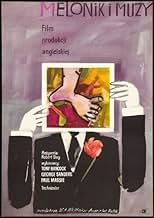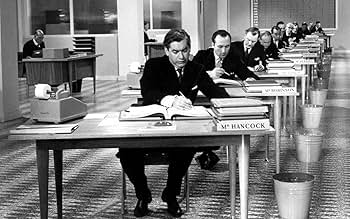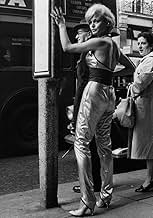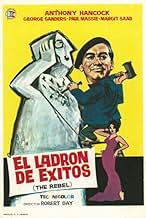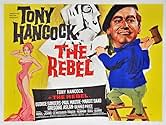The Rebel
- 1961
- 1h 45m
IMDb RATING
6.8/10
1.3K
YOUR RATING
Tony Hancock gives up his day job to become an artist. He's a lot of enthusiasm, but little talent, and critics dislike his work. Nevertheless, he impresses a talented artist.Tony Hancock gives up his day job to become an artist. He's a lot of enthusiasm, but little talent, and critics dislike his work. Nevertheless, he impresses a talented artist.Tony Hancock gives up his day job to become an artist. He's a lot of enthusiasm, but little talent, and critics dislike his work. Nevertheless, he impresses a talented artist.
- Nominated for 1 BAFTA Award
- 1 nomination total
Gary Cockrell
- Artist
- (as Gary Cockerill)
Featured reviews
I am 57 now and was weaned when I was a lad on the various BBC tv series of "Hancock's Half Hour in the 1950's.I became an addict there and then.In later life I carefully recorded the repeats on my vcr (not invented when I was a lad), and purchased cassettes of Tony's earlier radio shows whenever a new volume was available for sale.I have read his biography (1924 - his suicide in Australia in 1968), so he was only 44 when he died.Forget he had a drink problem and could be violent.
Yes, he considered he had outgrown his tv series with Sid James (and Kenneth Williams earlier) and even his later solo "Hancock" tv series from 1959 onwards.As a previous literate reviewer has rightly remarked, he hankered after a wider international audience for his comic abilities and appeared in later films like "Those Magnificent Men in their Flying Machines" even trying his hand in Hollywood with Walt Disney but I consider "The Rebel" from 1961 as his funniest film.It incorporates many characters like the existentialist lady on the big screen who have been heard before, e.g. Fenella Fielding in the radio show "The East Cheam Poetry Festival" from 1954.John le Mesurier often played "establishment" figures in his half hour shows and was a personal friend and here he plays Hancock's authoritarian boss in the dreary office where we first see him in an almost synchronised early scene where the clerks all do a similar computation function simultaneously.How we office workers with aspirations of individual creativity empathise with him in his rebellious behaviour!!
A new "Mrs Cravatte" in the shape of Irene Handle (not Patricia Hayes who was merely a char lady in the tv series), provides a female comic foil as Tony's landlady.It is interesting he retains his real name in this feature film, presumably he considered he could effectivly develop his bohemian character from the tv onto the broader canvas.I revisited this film after 20 years or so and laughed out loud in several places.The point already made that American/overseas viewers may be perplexed with his humour is easy to understand and our current UK generation may be left cold by it.My generation however which was reared on a diet of post war food rationing, spivs, watching wealthy Americans in the media, the McMillan type establishment figures in politics and industry, trends in fashion, pop music etc; can so empathise with his humour.I gave it 7/10.
Yes, he considered he had outgrown his tv series with Sid James (and Kenneth Williams earlier) and even his later solo "Hancock" tv series from 1959 onwards.As a previous literate reviewer has rightly remarked, he hankered after a wider international audience for his comic abilities and appeared in later films like "Those Magnificent Men in their Flying Machines" even trying his hand in Hollywood with Walt Disney but I consider "The Rebel" from 1961 as his funniest film.It incorporates many characters like the existentialist lady on the big screen who have been heard before, e.g. Fenella Fielding in the radio show "The East Cheam Poetry Festival" from 1954.John le Mesurier often played "establishment" figures in his half hour shows and was a personal friend and here he plays Hancock's authoritarian boss in the dreary office where we first see him in an almost synchronised early scene where the clerks all do a similar computation function simultaneously.How we office workers with aspirations of individual creativity empathise with him in his rebellious behaviour!!
A new "Mrs Cravatte" in the shape of Irene Handle (not Patricia Hayes who was merely a char lady in the tv series), provides a female comic foil as Tony's landlady.It is interesting he retains his real name in this feature film, presumably he considered he could effectivly develop his bohemian character from the tv onto the broader canvas.I revisited this film after 20 years or so and laughed out loud in several places.The point already made that American/overseas viewers may be perplexed with his humour is easy to understand and our current UK generation may be left cold by it.My generation however which was reared on a diet of post war food rationing, spivs, watching wealthy Americans in the media, the McMillan type establishment figures in politics and industry, trends in fashion, pop music etc; can so empathise with his humour.I gave it 7/10.
This one is a long-time favourite for its great one-liners, its wit, its bright colours and the sheer joy of its performances. George Sanders plays the creepy critic with the same finesse he'd done many times before, Hancock as the leader of the Infantile school of painting is so preposterous its hysterical, even a very young Oliver Reed appears briefly in the cafe scene. The writing of Galton and Simpson is as sharp as ever but gets to take more detours and turns than it ever could in the Half-Hours ... a brilliant film. I particularly love the pathetic painting of the foot which crops up at the art exhibition and that hideous sculpture. Excellent.
I remember seeing The Rebel, on general release, in Croydon - three or four miles from where the railway scenes were shot: a bygone branch line and now demolished station off Coombe Road. (We used to walk past it a couple of times each week in the 1950s in the Elmhurst 'crocodile' to play sports at Lloyd Park. Happy days, indeed.) Unfortunately, I have never been very comfortable with the film - and I have persevered with it over the years. The Hancock attitude quickly wears thin and the script is simply below par for these writers. Best scenes, apart from the nostalgia element, are those with Irene Handl; Margit Saad (best known to me from Magnificent Two)is easy on the eye, as ever, but must have been embarrassed with her banal Margot character.
Nevertheless, I am pleased that the picture has its adherents. Where is Margit Saad today? A directorial credit around 1990 and seemingly nothing since.
Nevertheless, I am pleased that the picture has its adherents. Where is Margit Saad today? A directorial credit around 1990 and seemingly nothing since.
An often overlooked and underrated Hancock vehicle as the Lad from East Cheam inadvertently becomes the toast of the art world when his flatmate's paintings are accidentally attributed to him instead of his own primitive childish daubs.
Great ensemble cast with John Le Mesurier as his boss, the sublime Irene Handl as his landlady Mrs Cravat and George Sanders as his pompous artistic agent.
At the films' centre is a sharp and nicely played critique of the hypocrisy and snobbishness of the art world with the usual taut Galton and Simpson script full of smart one liners.
"What's that?" asks Mrs Cravat looking at a bright pink picture of a man in a beret. "It's a self portrait" replies Hancock. "Who of?" counters Mrs Cravat.
Look out for a very young Nanette Newman as an Existentialist acolyte in the party scene and also Oliver Reed as a cafe artist.
8/10
Great ensemble cast with John Le Mesurier as his boss, the sublime Irene Handl as his landlady Mrs Cravat and George Sanders as his pompous artistic agent.
At the films' centre is a sharp and nicely played critique of the hypocrisy and snobbishness of the art world with the usual taut Galton and Simpson script full of smart one liners.
"What's that?" asks Mrs Cravat looking at a bright pink picture of a man in a beret. "It's a self portrait" replies Hancock. "Who of?" counters Mrs Cravat.
Look out for a very young Nanette Newman as an Existentialist acolyte in the party scene and also Oliver Reed as a cafe artist.
8/10
Tony is trapped in the drudgery of a 9-5:30 office job. But at night he is an artist who has great talent and vision (he believes). When he decides to quit his job and move to France he falls in with a group of artists who admire the `childlike' quality to his work. However when he passes another artists work off as his own and gets signed by a major agent he begins to get over his head in trouble.
For fans of Hancock's Half Hour on the BBC this film will represent strange new ground an extension of the short concise stories with depression being the overriding source of Hancock's comedy. Here the story sees him less put down and more of a winner this removes a lot of what made him funny.
However the story still has wit as Hancock makes fun of the pretentious art crowd and makes fun of his own inability to paint. However the running time is perhaps too long to sustain and much of the comedy is such that it could easily have been done by anyone rarely is Hancock's unique style allowed material to work with.
Hancock is still good though, and him misfiring is still funny. George Sanders has an interesting role and it's always good to see John Le Mesurier in anything. However at times you can't help feeling that Sid James could have been added somewhere. In fact the whole film would have been better modelled around the format of the TV and radio shows.
Overall this is the film failing it is stretched and, for most of the second half, it's comedy is not the usual Hancock fare that so many loved. It's funny but it'll make you seek out tapes and videos of his classic shows.
For fans of Hancock's Half Hour on the BBC this film will represent strange new ground an extension of the short concise stories with depression being the overriding source of Hancock's comedy. Here the story sees him less put down and more of a winner this removes a lot of what made him funny.
However the story still has wit as Hancock makes fun of the pretentious art crowd and makes fun of his own inability to paint. However the running time is perhaps too long to sustain and much of the comedy is such that it could easily have been done by anyone rarely is Hancock's unique style allowed material to work with.
Hancock is still good though, and him misfiring is still funny. George Sanders has an interesting role and it's always good to see John Le Mesurier in anything. However at times you can't help feeling that Sid James could have been added somewhere. In fact the whole film would have been better modelled around the format of the TV and radio shows.
Overall this is the film failing it is stretched and, for most of the second half, it's comedy is not the usual Hancock fare that so many loved. It's funny but it'll make you seek out tapes and videos of his classic shows.
Did you know
- TriviaThe film was a critical and commercial disaster in the United States.
- GoofsWhen the two bodyguards appear on the luxury yacht their shirts are buttoned and unbuttoned showing vests underneath.
- Crazy creditsThe producers wish to acknowledge the fullest co-operation accorded - somewhat apprehensively - by BRITISH RAILWAYS.
- ConnectionsEdited into Urban Myths: Les Dawson's Parisienne Adventure (2020)
- SoundtracksAt Last ! At Last !
(L'Âme des Poètes)
(uncredited)
Music by Charles Trenet
French lyrics by Charles Trenet
English lyrics by Florence Miles
- How long is Call Me Genius?Powered by Alexa
Details
- Release date
- Country of origin
- Languages
- Also known as
- Call Me Genius
- Filming locations
- Bingham Road railway station, Addiscombe, Croydon, London, England, UK(Fortune Green South Station)
- Production company
- See more company credits at IMDbPro
- Runtime
- 1h 45m(105 min)
- Aspect ratio
- 1.66 : 1
Contribute to this page
Suggest an edit or add missing content

